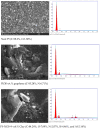Thermal Decomposition and Stability of Hybrid Graphene-Clay/Polyimide Nanocomposites
- PMID: 36679180
- PMCID: PMC9864696
- DOI: 10.3390/polym15020299
Thermal Decomposition and Stability of Hybrid Graphene-Clay/Polyimide Nanocomposites
Abstract
Polyimide matrix nanocomposites have gained more attention in recent years due to their high thermal stability, good interfacial bonding, light weight, and good wear resistance and corrosion, factors that make them find great applications in the field of aerospace and advanced equipment. Many advancements have been made in improving the thermal, mechanical, and wear properties of polyimide nanocomposites. The use of nanofillers such as carbon nanotubes, graphene, graphene oxide, clay, and alumina has been studied. Some challenges with nanofillers are dispersion in the polymer matrix and interfacial adhesion; this has led to surface modification of the fillers. In this study, the interaction between clay and graphene to enhance the thermal and thermal-oxidative stability of a nanocomposite was studied. A polyimide/graphene nanocomposite containing ~12.48 vol.% graphene was used as the base nanocomposite, into which varying amounts of clay were added (0.45-9 vol.% clay). Thermogravimetric studies of the nitrogen and air atmospheres showed an improvement in thermal decomposition temperature by up to 50 °C. The presence of both fillers leads to increased restriction in the mobility of polymer chains, and thus assists in char formation. It was observed that the presence of clay led to higher decomposition temperatures of the char formed in air atmosphere (up to 80 °C higher). This led to the conclusion that clay interacts with graphene in a synergistic manner, hence improving the overall stability of the polyimide/graphene/clay nanocomposites.
Keywords: clay; graphene; nanocomposites; polyimide.
Conflict of interest statement
The authors declare no conflict of interest.
Figures















References
-
- Ogbonna V., Popoola P., Olawale A.S.O. A review on recent advances on improving polyimide matrix nanocomposites for mechanical, thermal, and tribological applications: Challenges and recommendations for future improvement. J. Thermoplast. Compos. Mater. 2021;1:1–30. doi: 10.1177/08927057211007904. - DOI
-
- Doug W. Recent advances in polyimide composites. High Perform. Polym. 1993;5:77.
-
- Giannelis E., Krishnamoorti R., Manias E. Polymer-Silicate Nanocomposites: Model Systems for Confined Polymers and Polymer Brushes. Polym. Confin. Environ. Adv. Polym. Sci. 1999;138:107–147.
-
- Sinha Ray S., Yamada K., Okamoto M., Ueda K. New polylactide/layered silicate nanocomposite: A novel biodegradable material. Nano Lett. 2002;2:1093–1096. doi: 10.1021/nl0202152. - DOI
LinkOut - more resources
Full Text Sources

